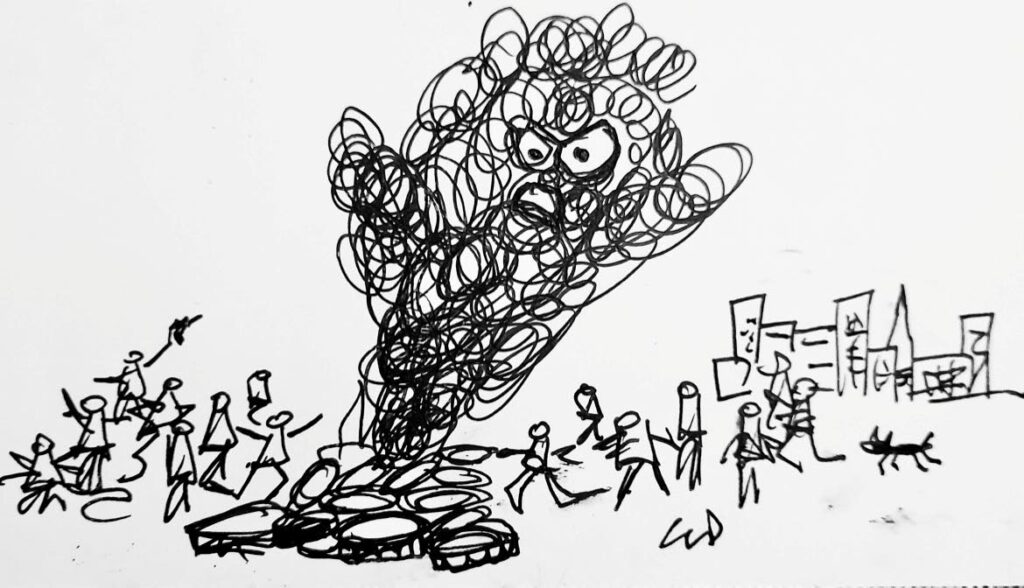We are tyred

A thick black column of smoke rising in the distance is not an uncommon sight in Trinidad (mainly) and Tobago.
“Someone is burning tyres,” the observer is likely to say, aware of the most common reason for the signature dark, billowing plumes.
Why do people in TT burn tyres? Some do, because they are not conscious of the implication of such actions and, instead of recycling old tyres, choose to dispose of them en masse in this unacceptable manner, polluting air, water and soil in the process. Such perpetrators most likely do not care (if they even know) that the black smoke emanating from their "rubber furnaces" contains heavy metals and a host of toxins that linger in the atmosphere, with the potential to cause conditions detrimental to our health, from short term to long term, acute to chronic – depending on length and degree of exposure to the hazardous waste.
Tyres are also burned as a form of protest against a range of ongoing, undeal-with societal frustrations affecting many citizens – poor road conditions, lack of water, landslips, poor infrastructure, rising prices, lack of law enforcement to list but a few.
Burning tyres is an enactment of the adage "to light a fire under someone" which means "to get someone to act quickly or forcefully, especially someone who has not being doing enough before" (Cambridge Dictionary). When societal problems seem bigger than "the people" whose cries continually seem to go unheard by those in authority, the fires of tyres send a strong message that enough is enough and something has to change now.
What is that "something" that has to change now? "Listening" – as basic as it sounds – is the first thing that comes to my mind. Carefully and caringly listening to someone else’s side (while suspending our own judgments on the matter at hand) is transforming and contagious; when we listen compassionately to others, they are more likely to respond to us in a similar manner.

Being able to express one’s feelings comfortably and be met with active, deep listening is fundamental to the foundation of any healthy relationship. It sets the stage for growth and change arising from clearer understanding of each other’s needs and intentions and opens the way for harmonious interaction, as opposed to defensiveness, discord or attack.
While this is applicable to all relationships, the one to which I specifically refer here is that of "the people" and our "leaders." Are they listening to us? Are we listening to them? What is missing from our conversations?
Last week, infuriated residents of East Port of Spain took to the streets, protesting the police killing of three youths from their community – youths whom protesters claim were innocent and were not (as was alleged) shooting at police during a high-speed chase in the early morning hours after the youths’ attendance at a Cocorite party.
It is understandable that many citizens may have been terrified or at least disturbed by the road-blocking and tyre-burning, as this could preface possible riots and violence.
At their most basic, such actions are a strident form of communication – a heated cry not easily silenced or suppressed, allowing the communicators sufficient time to "express" themselves (apparently a single tyre can burn for up to fifty minutes).
The burning of tyres is a visual version of talking drums. Just as the massive plumes of smoke can be seen for miles, conveying messages of discontent, so too can the sound of drums be heard up to five miles or more from their source. African talking drums send detailed messages from one village to another. During slavery, drumming patterns replicating tones of speech were used to deliver secret messages which defied the comprehension of slave masters. Quite like the Native Americans’ smoke signals (a quick way of communicating with distant tribes), the imposing black plumes arising from burning tyres send quick messages to those in authority.
If inclined, most, if not everyone in TT would be burning tyres now, for some reason – in an attempt to be heard, listened to and hopefully have our many needs met. Jokingly, yet seriously, such widespread protest action could be called the “We are tyred” movement.
Perhaps, rather than being seen only as a form of "protest," the burning of our tyres could be an actualizing of our national anthem’s "fires of hope and prayer" – prayers for the heeding of our collective cries and hope for tangible solutions to our nation’s problems.


Comments
"We are tyred"